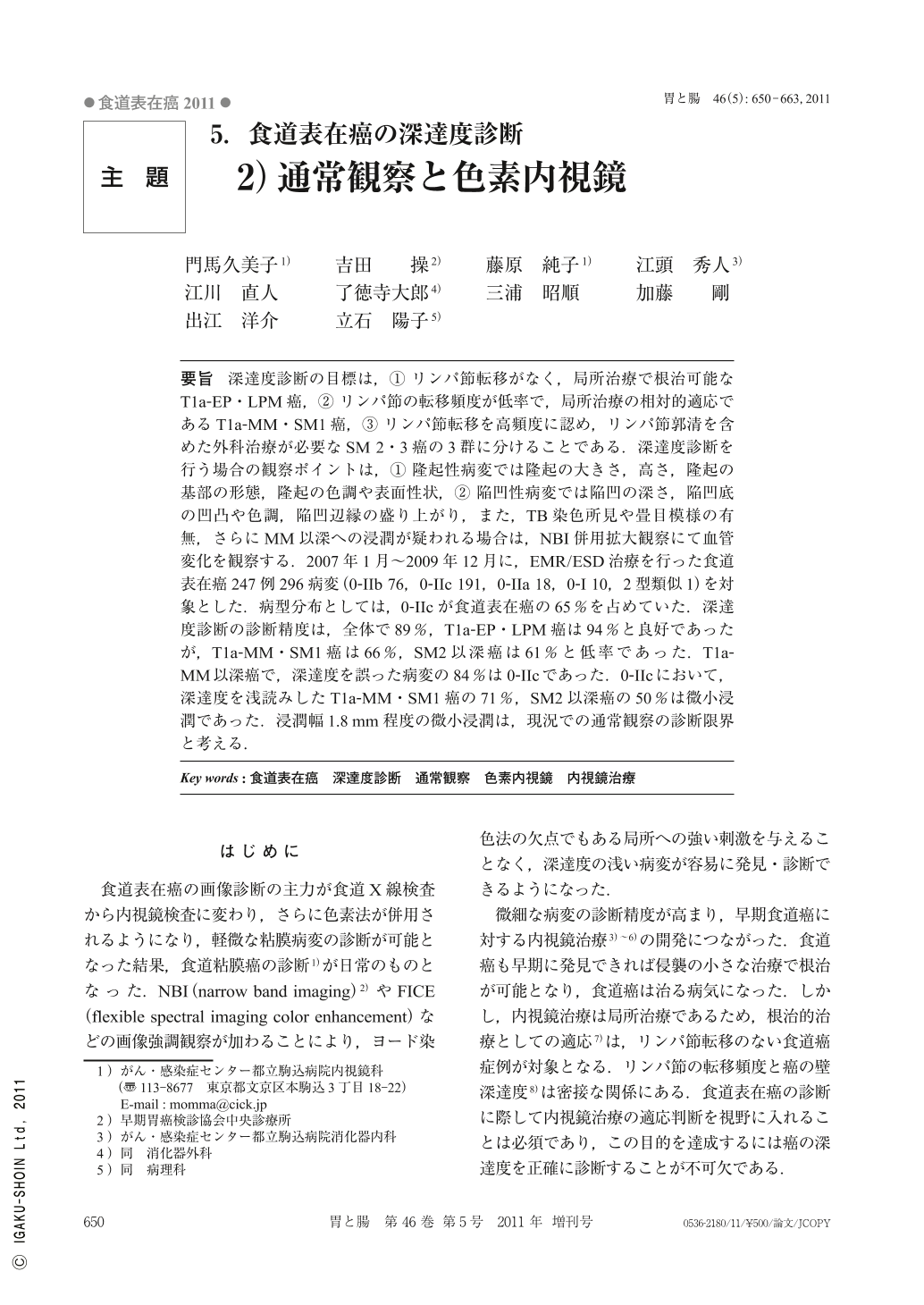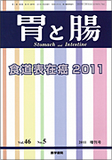Japanese
English
- 有料閲覧
- Abstract 文献概要
- 1ページ目 Look Inside
- 参考文献 Reference
- サイト内被引用 Cited by
要旨 深達度診断の目標は,(1)リンパ節転移がなく,局所治療で根治可能なT1a-EP・LPM癌,(2)リンパ節の転移頻度が低率で,局所治療の相対的適応であるT1a-MM・SM1癌,(3)リンパ節転移を高頻度に認め,リンパ節郭清を含めた外科治療が必要なSM 2・3癌の3群に分けることである.深達度診断を行う場合の観察ポイントは,(1)隆起性病変では隆起の大きさ,高さ,隆起の基部の形態,隆起の色調や表面性状,(2)陥凹性病変では陥凹の深さ,陥凹底の凹凸や色調,陥凹辺縁の盛り上がり,また,TB染色所見や畳目模様の有無,さらにMM以深への浸潤が疑われる場合は,NBI併用拡大観察にて血管変化を観察する.2007年1月~2009年12月に,EMR/ESD治療を行った食道表在癌247例296病変(0-IIb 76,0-IIc 191,0-IIa 18,0-I 10,2型類似1)を対象とした.病型分布としては,0-IIcが食道表在癌の65%を占めていた.深達度診断の診断精度は,全体で89%,T1a-EP・LPM癌は94%と良好であったが,T1a-MM・SM1癌は66%,SM2以深癌は61%と低率であった.T1a-MM以深癌で,深達度を誤った病変の84%は0-IIcであった.0-IIcにおいて,深達度を浅読みしたT1a-MM・SM1癌の71%,SM2以深癌の50%は微小浸潤であった.浸潤幅1.8mm程度の微小浸潤は,現況での通常観察の診断限界と考える.
One of the goals of the endoscopic evaluation of superficial esophageal cancer is to estimate depth of cancer invasion and classify them into three categories such as a)group A : superficial esophageal cancer with invasion of T1a-EP and T1a-LPM, that rarely has lymph node metastasis, b)group B : T1a-MM and T1b-SM1 with low incidence of lymph node metastasis and c)group C : T1b-SM2 and T1b-SM3, with frequent lymph node metastasis. Any local treatment that can eradicate cancer lesion provides radical treatment for group A. In cases with group B, most patients in this category can be cured by local treatment, but a small number of patients have lymph node metastasis and require additional treatment. Radical esophagectomy is recommended for group C.
In cases with elevated cancer lesions, endoscopic analysis on size, height, irregularity and color of the elevation, and shape of the base of lesion are points of diagnosis for estimation of depth of cancer invasion. In cases with superficial cancer with depression, grade of step down, irregularities in the depression and elevation close to the margin of depression help endoscopic estimation of depth of invasion. Dark blue staining by toluidine blue, interruption of fine transvers mucosal folds strongly suggest sites with deeper invasion. Magnify observation with narrow band imaging(NBI)allow us to detect micro-vascular abnormalities that are strongly suggestive of narrow and deeper invasion.
In order to clarify the accuracy of endoscopic evaluation of depth of cancer invasion, clinical and pathological diagnoses on 296 superficial cancer lesions in 247 patients were reviewed. Type 0-IIb lesion occupied 26%of all lesions, type 0-IIc 65%, type 0-IIa 6%and type 0-I 3%.
Depth of cancer invasion was correctly estimated by endoscopic studies in 89% of all lesions : 95% in T1a-EP and T1a-LPM, while 66% in T1a-MM and T1b-SM1 and 61% in T1b-SM2 or more.
In cases with T1a-EP and T1a-LPM, 92% of all lesions were type 0-IIc(61%)and type 0-IIb(31%). At the same time, type 0-IIc lesions were noted in 88.5% of all T1a-MM and T1b-SM1 lesions. In cases with T1b-SM2 and T1b-SM3, type 0-IIc lesions occupied 67% of all lesions and type 0-I 28%. Type 0-IIc lesions occupied 84% of all lesions with invasion of T1a-MM or more that failed in endoscopic estimation of depth of invasion. In cases with T1a-MM and T1b-SM1, micro-invasion was frequent among type 0-IIc lesions underestimated in depth of invasion(71%)while T1b-SM2 50%.
Conventional endoscopy aide by chromoendoscopy,NBI and magnify observation can detect deeper invasion of width 1.8mm or more.

Copyright © 2011, Igaku-Shoin Ltd. All rights reserved.


